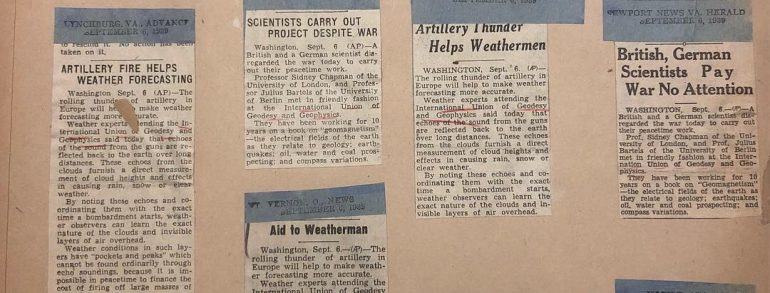By Vicki Zwart
While the United States did not enter into World War II until 1941, the American Geophysical Union felt its distressing effects much earlier. The Union had been planning since 1936 for the first General Assembly on American soil of the International Union of Geodesy and Geophysics (IUGG). But the growing threat of war in Europe had many calling for its postponement. AGU pushed ahead with its preparations and just as the meeting was about to open in September 1939 in Washington, D.C., Germany invaded Poland, starting the world war. Still, the assembly went on as planned, although no administrative or financial matters were discussed – only scientific work was shared.
Despite the increasing hardships of the war, attendance at AGU’s Annual Meetings stayed steady with some 400-500 registrants a year. Union General Secretary John Fleming wrote in Transactions, Vol. 24, no. 1, that “now, as never before, scientists in general of the Western Hemisphere need to affiliate and play their part not only in the immediate programs of applications to war effort … but the rehabilitation of international relations and endeavors particularly necessary to investigation of Earth-physics.”
But the war did take its toll on the Union through increased costs and fewer volunteers (due to service in the armed forces) available to continue essential and expanding operations. By 1944, volunteers could not keep up with the increasing responsibilities, so a full-time salaried Executive Secretary and three staff members were hired.
During the war, AGU focused on continuing its international progress and cooperative efforts. Numerous resolutions were adopted, emphasizing geophysics applications in the war effort, including meteorology and seismology, along with post-war preparation. At the Annual Meeting in 1942, then AGU president Walter Lowdermilk called the Union “more a child of peace than of war … we have in our hands one of the great instrumentalities for bringing in a new age of creative endeavor.”
Factoids:
The outbreak of WWII meant that the German contingent did not attend IUGG; they missed the presentation by Athelstan Spilhaus Sr. of his paper on the bathythermograph, a device cited as one of two instruments that won the war in the Atlantic. It detects the presence of thermoclines (colder parts of water where submarines could hide undetected).
To cover the costs of hiring a full-time Executive Secretary and staff, special voluntary contributions were solicited from associates totaling $10,000. Another $20,000 was granted by the Rockefeller Foundation. The $30,000 would cover three years – July 1944 to June 1947.
The Section on Tectonophysics was established in 1940, for the “purpose of promoting and encouraging research of fundamental importance to knowledge of Earth structure not covered by any of the other Sections of the Union.”



